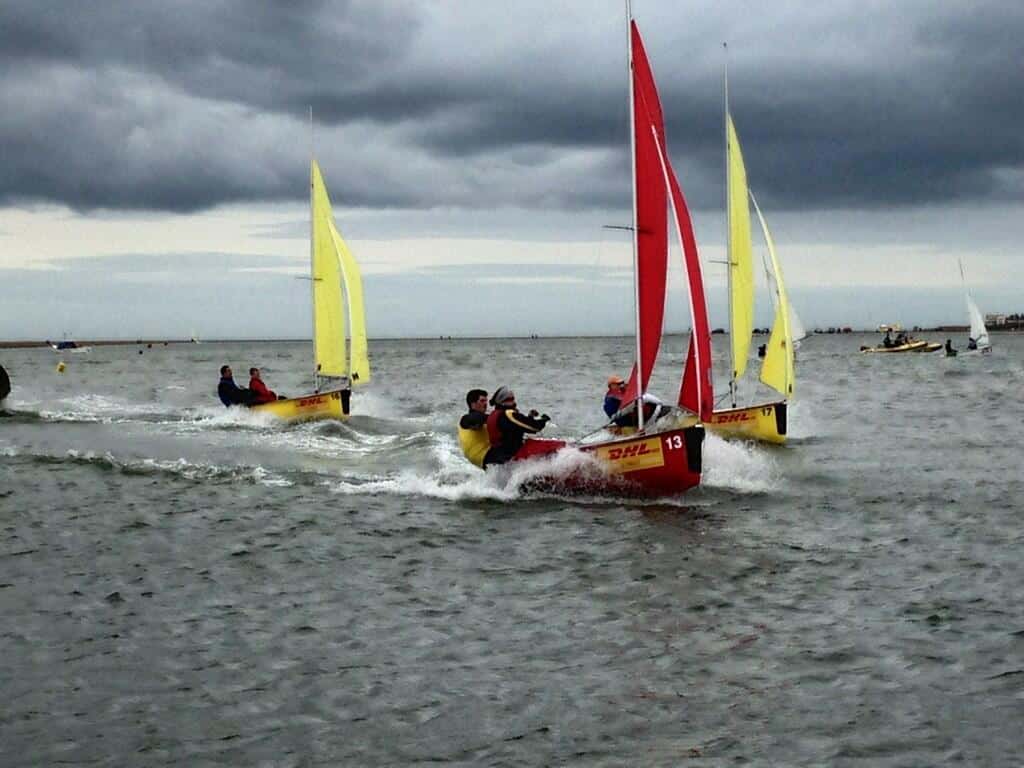
Wilson Trophy 2013
Today dawned grey with a hint of drizzle. We got to the club by 7:30 a.m. and quickly dressed, skipping coffee and breakfast in order to make it to the boats that were already awaiting us by the water. Our first race started just after 8:00 a.m. in about 5 knots, leading to a whole new set of potential boathandling concerns—unlike college sailing, you can’t come out of a tack or jibe faster than you went into it, and with umpires everywhere there’s no chance of slipping by unnoticed.
The boats glided smoothly in the light air across the flat water, even with us rolling a fraction of how we would in college sailing, and after a conservative start we converted to a 1-2-5 without too many issues against New York Yacht Club with my boat in the 5. On the final beat, the NYYC boat in the 6 was flagged for breaking Rule 42 for rocking an infinitesimal amount. Watch out.
Sailing with so many umpires watching our every move is not something I do very often, and so far this regatta has been a pretty rough crash course in what not to do. Yesterday, we waited too long before flying the yellow flag (you must fly the red flag for about 5-10 seconds, making sure that the umpire sees you, and then if the boat you’re protesting doesn’t spin, fly the yellow to call for a referee), and so one of our protests got green flagged, meaning that no one had to spin. Lesson #1: Time the flags correctly. The flags are kept in the crew’s lifejacket, so although the skipper makes the call of when to fly them, I feel responsible for making sure they’re executed correctly. To keep up consistency, it’s red on right, yellow on left, attached by a small bungee wrapped around each of my lifejacket straps.
By the time we started our second race, the breeze had picked up to 10-20, where it stayed all day. That didn’t mean that we were out of the woods, though; we had three bad run-ins with the umpires. First, let me say that I’m incredibly impressed with the umpires at this regatta; they represent a total of seven different countries and all funded their trips here with their own money. All of the sailors are indebted to their dedication. That said, there are bound to be differences in opinion, a few of which we encountered today. They can all be chalked up to lessons learned, although the hard way.
In what I believe was our third race, we fouled port-starboard at about 30 seconds. Pinned between two of our opponents, Greenfield yelled “we’re spinning!” while we struggled to get clear enough to do our penalty turn. Despite his hailing and our attempts to get clear, we got red flagged, and ended having to do two-turns instead, _after _we were slowly shot out the back. We started the race in a deep 6, completely unable to help our teammates. After the race was over, we sailed to the umpire boat to ask them what they had seen. Apparently, we hadn’t hailed loudly enough that we were spinning. Lesson #2: Be as clear and as loud as possible when it comes to communicating with the umpires.
A couple races later, we again ran into trouble. We were in a precarious combination, the 4 in a 1-4-6, and were tightly covering our opponent after the leeward offset. An umpire boat motored straight into our path, and we had to tack off, losing our guy and ultimately the race. We didn’t know what to do; Greenfield didn’t think that we could seek redress, and I had no idea. Apparently, had we flown the red flag, we could have had a shot at a re-sail. Lesson #3: Be quick to fly the red flag. You can only really get in trouble if you improperly fly the yellow, and you have no shot at redress if you don’t.
Two races after that, we ran into trouble once again. We lost flow on the starting line, and were stalled and trying to bear off at GO when the block on the end of the boom burst off. I flew the red flag immediately, keeping in mind Lesson #3, but the judges told us to keep on sailing. Trimming and easing were difficult for Greenfield, and we sailed around the course in a downspeed 6. After finishing the race in a losing 1-5-6 we filed for redress, as the screw in the block had come out, not merely a ring ding. We were denied a re-sail. Why? Because we had been in the “deep 6” when our boat broke, even though we could have easily had a fighting chance to catch up quickly if we’d had a functioning main. Lesson #4: Win on the water.
Despite these pitfalls, we’re well within striking distance for the quarterfinals tomorrow, in which the top eight teams will sail with the winners then moving on to semifinals and the subsequent finals. The Swiss League format ensured that we didn’t have a single dull race, and that there wasn’t a single moment when we could let our guard down. As one of the Royal Thames skippers said, “The Swiss League is a right emotional rollercoaster, yeh?” I couldn’t agree more. Now it’s time to find out just what they mean by “God save the Queen.”
Amelia Quinn is a senior at Tufts University, studying a little bit of Arts and Sciences and a lot of sailing. Check out her blog Rolling Start for more on the Wilson Trophy!









